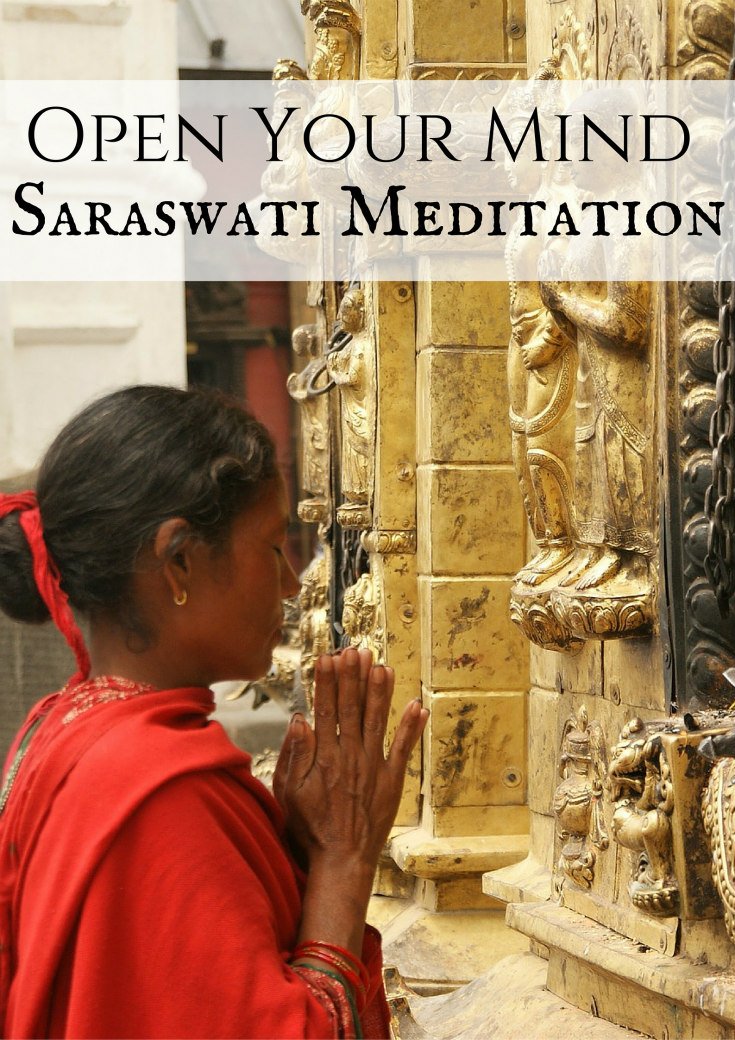Lately, I’ve been all about the Hindu pantheon. Each image of Hindu deities are so beautifully intricate and exotic, sometimes depicted as the fantastic merging of human and beast, each representation loaded with detail and symbolism. There are the biggies like Shiva, Parvati and Vishnu, and we all know and love the elephant-headed remover of obstacles, Ganesha!
One of my favorite deities right now is Saraswati, the goddess of knowledge, wisdom, the arts and nature–what a perfect goddess to keep in mind here at Blue Osa! She is traditionally depicted as having four arms (representing her omnipotence) in a glowing white sari (the color of purity, intellect and enlightenment) while sitting on top of a lotus, the symbol of supreme reality and knowledge. She’s often pictured with swans, representing the power of discrimination, and a peacock that denotes the transcendence of fear and indecision to find the true knowledge which resides in the self.

Saraswati is also depicted as a beautiful woman to represent how alluring and seductive true, pure intellect is! Lessons on the Vedas often begin and end with chants as students ask her to bestow them with her blessings as they study. School children can also be seen muttering mantras to her before a big exam, and she is a favorite of musicians, writers and poets. People also recite her prayers to improve their memory, intelligence, and even powers of public speaking. The goddess is widely adored, and one of the most popular Sanskrit prayers is dedicated to Saraswati:
Saraswati Meditation For Knowledge
“May Goddess Saraswati,
who is fair like the jasmine-colored moon,
and whose pure white garland is like frosty dew drops,
who is adorned in radiant white attire, on whose beautiful arm rests the veena,
and whose throne is a white lotus,
who is surrounded and respected by the Gods, protect me.
May you fully remove my lethargy, sluggishness, and ignorance.”
Sounds like we could all use a little Saraswati power now and then! If you’d like to ignite your day with the power of intellect and discriminating wisdom, try this Saraswati meditation for knowledge. It’s best performed in the morning, when your mind is clear and open.
How to practice the Saraswati meditation for knowledge:
Sit in a comfortable seated position with a tall spine, your sitting bones rooting down into the Earth. Begin by focusing on your breath, matching the inhales to the length of the exhales (sama vritti). Slowly begin to deepen your breath, expanding all four corners of your torso. Feel each breath nourish and energize the tissues of your body. Breathe this deep, rich breath for a few moments. When the time feels right, recite this mantra, either out loud or in your mind:
Om Shri Saraswati-ya Namaha
(Aum Shree Sara-SVAH-tee-yah NAH-mah-hah)
Do this slowly, to the rhythm and pace of your breath. It could be a few moments, ten minutes, or even longer. Let your intuition guide you. When you feel that you have sufficiently repeated the mantra, take a few moments in silence, returning to your breath, noticing the sensations you feel in your body.
Rub the palms vigorously together, creating heat, then place them over your eyes and breathe in deeply. Open the eyes into the palms, then lower the hands. Go about your day and see where you can find the blessing of Saraswati!
About the Author
Raquel is inspired, challenged, ignited and balanced by yoga, and is honored to teach such a sublime practice. She started on the path of yoga in 2007, and realized few other things allowed her to connect with her body in a joyful, powerful way. Her first downdog led to countless others, and in 2012 she completed her 200-hr certification at Moksha Yoga. She leads creative and playful classes, linking breath with movement and incorporating breathwork and meditation for a well-rounded, comprehensive practice. She is grateful to Ashley Turner, Seane Corne, Rod Stryker, Aadil Palkhivala and many others for their teachings that influence her own practice.
When she’s not teaching, Raquel is a holistic wellness coach specializing in helping women cultivate nourishing relationships with their bodies. She remains passionately curious about yoga, wellness, tribal arts and indigenous herbalism, and continues her studies to better serve her students. A proud lifelong Chicagoan, Raquel also loves running, writing fiction, growing food and cooking with it, magical-realists, and mid-morning dark chocolate.
Visit her at raquelalexandra.com







